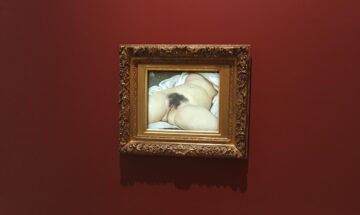Brian Ng at Art In America:
 Lacan collected works by the likes of Duchamp and Picasso, which he displayed proudly in his country home. But to be sure, the most iconic work of his collection, also on view, was Gustave Courbet’s L’Origine du Monde (1866); today, it is owned by the Musée d’Orsay. Famously, Lacan hid this detailed rendering of a vulva behind a sliding wooden door, onto which his friend (and eventual brother-in-law) André Masson painted his own Surrealist rendition. Masson added clouds that drift above an outline of L’Origine’s body, whose curves he recast as hills, her pubic hair resembling a bunch of flowers. L’Origine du Monde almost never leaves d’Orsay. But at the Pompidou-Metz, it no longer hangs alongside other 19th-century works, which often feel prudish in L’Origine’s presence. Instead, the curators have hung it beside more recent representations of vulvas—some of them direct retorts to the famous L’Origine—by the likes of Art & Language, Mircea Cantor, VALIE EXPORT, Victor Man, Betty Tompkins, and Agnès Thurnauer. Deborah de Robertis’s photograph hangs near L’Origine, showing a 2014 performance in which the artist, wearing a gold dress referring to the painting’s gilded frame, squatted in front of the work, spreading her legs wider than Courbet’s model topart her vagina, revealing what she calls “infinity,” or “the origin of the origin,” the depth that Courbet concealed.
Lacan collected works by the likes of Duchamp and Picasso, which he displayed proudly in his country home. But to be sure, the most iconic work of his collection, also on view, was Gustave Courbet’s L’Origine du Monde (1866); today, it is owned by the Musée d’Orsay. Famously, Lacan hid this detailed rendering of a vulva behind a sliding wooden door, onto which his friend (and eventual brother-in-law) André Masson painted his own Surrealist rendition. Masson added clouds that drift above an outline of L’Origine’s body, whose curves he recast as hills, her pubic hair resembling a bunch of flowers. L’Origine du Monde almost never leaves d’Orsay. But at the Pompidou-Metz, it no longer hangs alongside other 19th-century works, which often feel prudish in L’Origine’s presence. Instead, the curators have hung it beside more recent representations of vulvas—some of them direct retorts to the famous L’Origine—by the likes of Art & Language, Mircea Cantor, VALIE EXPORT, Victor Man, Betty Tompkins, and Agnès Thurnauer. Deborah de Robertis’s photograph hangs near L’Origine, showing a 2014 performance in which the artist, wearing a gold dress referring to the painting’s gilded frame, squatted in front of the work, spreading her legs wider than Courbet’s model topart her vagina, revealing what she calls “infinity,” or “the origin of the origin,” the depth that Courbet concealed.
more here.
